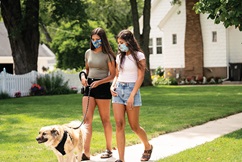In this section
Community partners and professionals
- Child abuse prevention
- Child Advocacy and Protection Services (CAPS)
- Child Welfare Services
- Memberships and accreditation
- Child well-being: Strong Families, Thriving Children
- Resources for schools
- Nutrition ages 2 to 4
- Nutrition ages 5 to 12
- Nutrition 13 and up
- Physical activity ages 2 to 4
- Physical activity ages 5 to 12
- Physical activity 13 and up
- Healthy minds ages 2 to 4
- Healthy minds ages 5 to 12
- Healthy minds 13 and up
Healthy minds-ages 13 and up
Share this information with your family to understand mental and emotional health, practice being mindful, learn ways to be more focused and engaged and check out some useful tips about sleep.
Mental and emotional health
What is mental and emotional health?
 Mental health and emotional health are often used interchangeably, but they actually mean different things.
Mental health and emotional health are often used interchangeably, but they actually mean different things.
- Mental health includes emotional, psychological and social well-being.
- Emotional health is part of mental health, and includes thoughts, feelings and emotional expressions or behaviors.
Stigma and mental health
In our culture, there is a stigma surrounding mental health, and it's important that we try and remove that stigma. Mental health stigma includes negative attitudes and beliefs about people with mental illness and often come from a lack of understanding. The feelings toward mental health can get in the way of seeking treatment for a mental illness, can lead to problems at school or work, bullying and self-doubt.
Here are some ways to help reduce stigma:
- Talk openly about mental health to people you know, making it more relatable for others.
- Educate yourself about mental health. When possible, help educate others.
- Use respectful language that puts the person before the disorder. People-first language helps to see the person and not the condition. For example, say "a person with depression" or "a person with anxiety."
- Avoid labels in our society that contribute to creating stigma.
- Be supportive if you think someone is struggling with their mental health.
Anxiety
It's important to know that worrying can be part of anxiety, but anxiety isn't always centered on worrying. Anxiety in teens is common. You may want to take some steps to help them manage anxiety if it starts to interfere with daily activities and if it impacts their decisions in a negative way.
Video: Ask the experts | Anxiety in teens and how to help
Anxiety symptoms can include:
- Rapid breathing
- Sweating
- Nausea
- Tense muscles
- A thumping or rapid heart rate
- Feelings of dread
There are a number of things that you can do to help your teen cope if they are experiencing anxiety symptoms:
- Work through the problem with your teen. Creating a plan for how to manage the situation can help ease their anxiety.
- Be a role model by handling anxiety in a healthy way. How you cope with anxiety shows your teen how they can help manage theirs.
- Be encouraging, listen and let them know that you're confident they will get through the situation.
Visit this KidsHealth page to learn more about anxiety and anxiety disorders.
Talking to your teen about healthy relationships
Teens are growing up and starting to build important friendships and romantic relationships. These relationships shape the way in which teens interact with their peers and family members. Help them build healthy relationships by talking with your teen about them.
A healthy relationship includes:
- Working together for a balanced relationship
- Talking with each other about feelings
- Supporting and listening to the other person
- Respecting one another
- Trust and honesty
- Equity and fairness between friends or romantic partners
- Individuality
- Clear communication
Video: Conversation starters | Talking to your teen about healthy relationships
Visit this KidsHealth page discussing healthy friendships.
Building resilience
All teens face problems, and being resilient can help them to succeed. Resilience is the process of adapting well during instances of trauma, adversity, threats or other sources of stress. Someone who is resilient has emotional support and tools necessary for coping. Working with teens to help them focus on positive emotions instead of negative ones can be helpful in solving problems as they come up.
Here are some ways you can help build resilience:
- Have a strong support system.
- Take care of yourself physically, mentally and emotionally.
- Learn from the negative events.
- Structure your days.
- Prepare for bad days.
- Strive to stay hopeful.
Video: Ask the experts | Building resilience in kids
Check out the KidsHealth webpage on what power positive emotions have.
Suicide
Suicide is complex, and while rare in childhood, rates increase in teens and young adults. It's important to know about the warning signs of suicide and to have open and honest conversations with your teens about it and how to ask for help.
 Different factors can increase the risk of suicide. These factors can include:
Different factors can increase the risk of suicide. These factors can include:
- Mental illness, especially depression, bipolar disorder and alcohol or drug use
- Feeling a sense of hopelessness and worthlessness
- History of suicide in the family or previous suicide attempt
- Physical, emotional or sexual abuse
- Limited support network leading to feelings of social isolation
Some warning signs include:
- Giving away prized possessions to family members or friends
- Loss of interest in school, sports or other previous interests
- Increase in risk-taking behavior
- Bringing up suicide or death in conversation
- Mentioning that they may not be around soon
- Struggling to concentrate or think with a clear mind
How to help:
- Take notice of any warning signs.
- Do not minimize problems; listen to your teen.
- Ask clarifying questions while minimizing judgment.
- Get help when needed.
If you find yourself in a situation that could use immediate help, call (800) SUICIDE (784-2433)
Find suicide information for your teen on this KidsHealth page.
For information on what to do when a friend is talking about suicide, read this KidsHealth page.
Mindfulness
What is mindfulness?
 Mindfulness is a research-based tool that starts with purposefully bringing focus to thoughts, emotions, physical feelings and environment. It allows teens to learn how to pause, which can be very beneficial for them both in school and at home. Mindfulness can improve concentration, improve exam performance and reduce symptoms of stress, anxiety and depression. This skill gets better and easier with time and practice. Interested in learning more about the connection between the brain and mindfulness? Watch this TED Talk.
Mindfulness is a research-based tool that starts with purposefully bringing focus to thoughts, emotions, physical feelings and environment. It allows teens to learn how to pause, which can be very beneficial for them both in school and at home. Mindfulness can improve concentration, improve exam performance and reduce symptoms of stress, anxiety and depression. This skill gets better and easier with time and practice. Interested in learning more about the connection between the brain and mindfulness? Watch this TED Talk.
Ways to practice mindfulness
- Encourage your teen to keep a gratitude journal that can include mindful observations in the form of lists, poems, or drawing creations.
- Get a Hoberman sphere (En Español) for your home to help practice breathing exercises.
- Create and use a mindful jar (En Español) to teach them about how strong emotions can take hold.
- Search for some mindfulness coloring sheets for your teen that use shapes and patterns to encourage a calming mindful experience.
- Have your teen utilize Take 5ive videos that offer three types of guided exercises designed to develop focus and attention skills, cultivate everyday kindness, compassion and gratitude, and reset and attune the mind-body connection through movement.
Screen time
What is screen time?
 Screen time includes watching TV, using a cell phone or tablet, working on a computer or playing video games. Screen time is a sedentary activity that can have a negative impact on overall health. The recommendation is to limit screen time to a maximum of two hours each day. Kids age eight-18 spend about six hours a day in front of a screen. Add on school-related screen time and kids spend on average 7.5 hours daily.
Screen time includes watching TV, using a cell phone or tablet, working on a computer or playing video games. Screen time is a sedentary activity that can have a negative impact on overall health. The recommendation is to limit screen time to a maximum of two hours each day. Kids age eight-18 spend about six hours a day in front of a screen. Add on school-related screen time and kids spend on average 7.5 hours daily.
Impact of screen time
- Increased obesity, decreased energy and a more difficult time in school
- Aggressive behavior, due to the tendency of kids to copy what they see
- More commercials and advertisements viewed can change teen buying habits
Screen time before bed can:
- Negatively impact how much and how well kids sleep
- Light from a screen can keep teens awake and impact sleep cycles
How to reduce screen time
Modeling good behavior by reading books or getting outside to be active is a good way to help teens reduce their screen time. At home, encourage healthy behaviors and limit unhealthy ones to help build healthy habits. Watch out for any behavioral changes, such as increased irritability, selfishness or impatience. Avoid TVs and electronics in bedrooms to reduce screen time and improve quality of sleep.
Set limits to screen time so that your teen can engage in activities like outside sports, reading, music or the arts.
Video: Conversation starters | Reducing screen time
Sleep
Why sleep is important?
Teen brains are still developing, and sleep is integral to this growing process. It's recommended that teens get between 8 and 10 hours of quality sleep on school nights.
Getting enough sleep helps:
- Teens perform better in school
- Protect mental and emotional health
Lack of sleep can lead to:
- Engagement in risky behaviors
- Changes and difficulty in controlling emotions
- Increased chance of mental illness
- Affecting ability to drive
How to help teens get enough sleep
- Limit screens before bed
- Normal exercise
- No caffeine 4 hours before bedtime (includes: sodas, caffeinated tea, coffee)
- Eat regularly
- Keep a regular bedtime routine
- Create a safe, dark, quiet and cool bedroom for sleeping
Balance and stress
Types of stress
 There are three main types of stress: acute stress, episodic acute stress and chronic stress. Stress is the response people have to different threats and pressures.
There are three main types of stress: acute stress, episodic acute stress and chronic stress. Stress is the response people have to different threats and pressures.
Acute stress is the most common type. This type of stress arises from demands and pressures from the past, current time and anticipated near-future demands. Too much acute stress can be exhausting, but it can be helpful in small doses.
Episodic acute stress is acute stress that happens frequently. People who worry ceaselessly experience this type of stress.
Chronic stress is the type that wears away at people day after day. Things like poverty or a dysfunctional home life are examples of chronic stress. This type of stress occurs when people can't see a way out of a hopeless or miserable situation.
How to know when it's too much and how to help
When stress becomes too much to handle, there are both physical and emotional symptoms.
Some symptoms that arise when there is just too much stress:
- Headache, stomachache or muscle pain
- Chronic tiredness
- Withdrawing from activities and people
- Anger or feelings of irritability
- Feelings of hopelessness, anxiety or nervousness
- Changes in eating and sleep patterns
If you notice any of these symptoms in your teen, be sure to talk to them about their stress and discuss some ways to ease some of the stress. If you suspect a serious problem, please contact your child's physician.
Here are some ways you can help a stressed teen:
- Focus on creating a balanced lifestyle. Make sure that the necessary activities, like studying, are paired with activities that they enjoy.
- A good night's sleep. Getting a good night sleep prepares teens for the day ahead with greater energy and often a better mood.
- Choose healthy. Eating right supports a better mood, lower stress and an energy filled day.
- Plan on planning. Work with your teen to set up a schedule and record the responsibilities in a planner or some calendar. These visual tools can help and many are online, where they can set reminders.
- Build in exercise. Emphasize the importance of being physically active every day as it is a great tool to manage stress levels.
- Practice different stress management techniques, like belly breathing, progressive muscle relaxation techniques and setting realistic goals.
Watch this teens talk about stress video from KidsHealth.
Healthy minds resources
Mental and emotional health resources
Read about mental health and what it is. | En Español
Tips on ways to talk to your teen about healthy relationships.
Learn more about managing anxiety.
Children's Wisconsin is committed to addressing the mental and behavioral health crisis facing our children. Children's Shine Through awareness initiative brings to life the important work Children's is doing to detect needs sooner, reduce stigma and improve access to care for kids with mental and behavioral health needs. Learn more about Shine Through.
Mindfulness resources
Learn about mindfulness and how it can help your teen by checking out our Mindfulness tip sheet.
A Hoberman sphere is a great tool to learn to be mindful. Read more on our Hoberman Sphere fact sheet. | En Español
Screen time resources
Learn about screen time and ways to reduce it using our fact sheet. | En Español
Suicide resources
National Suicide Prevention Lifeline (800) 273-8225
